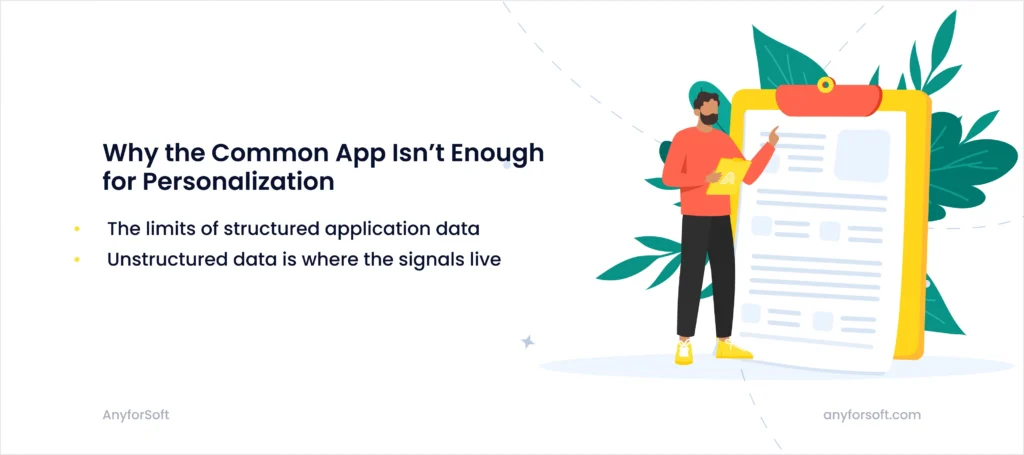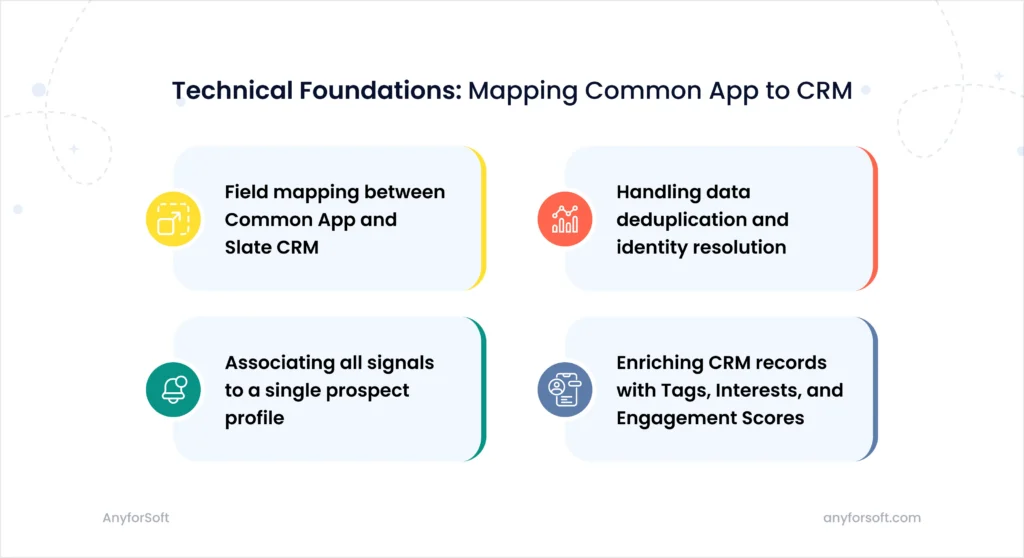From Common App to CRM: Making Sense of Structured and Unstructured Applicant Data
Your admissions team just downloaded 3,000 Common App submissions. Each one contains essays, financial aid forms, and activity lists that could tell you whether Sarah is passionate about sustainability research, if Marcus needs merit-based aid to attend, or whether Taylor’s leadership experience makes them perfect for your honors program. These signals should drive your engagement strategy.
Instead, most of that intelligence sits buried in unstructured text while your CRM segments students by nothing more sophisticated than GPA ranges and geographic location. You’re sending the same generic email about “campus life” to the pre-med student who wrote about healthcare equity and the business major interested in entrepreneurship.
As the higher education landscape becomes increasingly competitive, universities are turning to data analytics to optimize their admissions strategies, yet most institutions only leverage the structured pieces. Here’s how forward-thinking admissions teams are changing that reality — turning messy application data into precise, personalized outreach that moves the needle on yield rates.
In this article, you’ll learn:
- How to systematically parse Common App data for actionable insights beyond basic demographics.
- Technical approaches for mapping Common App fields to CRM and handling identity resolution.
- Methods for extracting interest signals from essays using natural language processing.
- Architecture for connecting your CRM to marketing and analytics platforms.
- What your development team needs to implement these integrations securely.
Why the Common App Isn’t Enough for Personalization

The Common Application provides a standardized framework that simplifies the application process for students and creates consistent data structures for institutions. But standardization has limits when it comes to understanding individual student motivations and interests.
The limits of structured application data
Structured and unstructured applicant data serve different purposes in your enrollment strategy. Structured data — GPA, test scores, intended major, demographic information — helps admissions teams make initial admission decisions and broad categorizations.
This structured information answers questions like “Does this student meet our academic criteria?” and “Where are our applicants coming from geographically?” But it doesn’t reveal why Maya chose environmental science, whether David will need work-study opportunities, or how Jennifer’s leadership style might contribute to campus culture.
Traditional CRM segments based on structured data look like this:
- High-achieving STEM applicants (GPA > 3.8, intended engineering major).
- Out-of-state prospects (geographic flag).
- First-generation college students (demographic checkbox).
These segments enable basic targeting but miss the nuanced interests and motivations that drive enrollment decisions.
Unstructured data is where the signals live
Unstructured applicant data contains the richest intelligence about student interests, values, financial circumstances, and engagement preferences. Personal statements, activity descriptions, and supplemental essays reveal:
- Career aspirations and research interests: Students who write about shadowing physicians, environmental advocacy, or entrepreneurship ventures.
- Financial context: References to work-study needs, scholarship requirements, or family financial circumstances.
- Values and motivations: Community service focus, social justice interests, or creative pursuits.
- Leadership and collaboration styles: How students approach teamwork, problem-solving, and project management.
Based on our observations working with higher education clients, institutions that systematically analyze this unstructured content see 25-40% improvements in yield rates for targeted communications compared to generic outreach campaigns.
Bridging the Gap: Parsing and Enriching Applicant Data
The challenge lies in systematically extracting meaningful signals from thousands of essays and forms, then connecting those insights to actionable CRM segments.
Using NLP to extract signals from essays and forms
Parsing Common App data requires natural language processing tools that can identify themes, keywords, and context clues across large volumes of text. Modern NLP systems analyze semantic meaning rather than just keyword matching.
Our findings indicate that NLP technology allows admissions officers to personalize the application process by tailoring questions and prompts to each applicant. By analyzing the applicant’s background, interests, and achievements, NLP algorithms can generate relevant insights for segmentation and outreach.
The parsing process identifies several categories of signals:
Academic and Career Interests: Beyond the stated intended major, essays reveal specific research areas, professional goals, and intellectual curiosities. A student declaring “Biology” as their major might write extensively about marine conservation, indicating interest in environmental programs and research opportunities.
Extracurricular Engagement Patterns: Activity descriptions show leadership styles, collaboration preferences, and time commitment levels. Some students emphasize individual achievement; others focus on team building and community impact.
Financial and Support Indicators: While students don’t always explicitly state financial need, essay language often contains indirect references to work experiences, family circumstances, or scholarship considerations.
Identifying interests (e.g., Athletics, Arts, STEM) from text inputs
Student engagement segmentation becomes possible when you can identify specific interest areas from the application text. The system looks for patterns that indicate depth of engagement rather than casual interest.
Thanks to our practical knowledge in this area, we’ve found that athletic interests require analysis beyond simple sport mentions. The system identifies:
- Competitive experience and achievement levels.
- Team leadership roles and coaching experience.
- References to training discipline and goal-setting.
- Injury recovery narratives or sports science interests.
Arts engagement signals include:
- Creative process descriptions and artistic development.
- Performance experience and audience engagement.
- Collaborative projects and creative leadership.
- Arts education and mentorship experiences.
STEM indicators extend beyond grades and test scores to include:
- Research project descriptions and methodology references.
- Problem-solving approaches and analytical thinking.
- Science fair participation and engineering challenges.
- Technology development and coding projects.
Surfacing Financial Need, First-Gen Status, or Motivation from Language
Drawing on our own experience with admissions data analysis, certain language patterns reliably indicate financial circumstances and family educational background without requiring explicit disclosure.
Financial need indicators often appear as:
- Work experience descriptions emphasizing family support.
- References to budgeting, saving, or resource management.
- Community college coursework or dual enrollment mentions.
- Geographic references to lower-income areas or rural communities.
First-generation college status emerges through:
- Family pride and responsibility themes.
- Navigation challenges and support system descriptions.
- Career advancement aspirations for family benefit.
- Uncertainty about college processes or academic expectations.
Attaching behavioral data: web visits, email opens, chat transcripts
Event tracking for admissions extends beyond application content to include digital engagement patterns. Applicant behavior analytics track how students interact with your website, emails, and other touchpoints.
Behavioral signals include:
- Program page visits and time spent on specific content.
- Email engagement patterns and content preferences.
- Virtual event attendance and participation levels.
- Live chat questions and information requests.
Combining application content analysis with behavioral data creates more accurate interest predictions than either data source alone.
Technical Foundations: Mapping Common App to CRM

The technical implementation requires careful planning around data structure, identity management, and system integration.
Field mapping between Common App and Slate CRM
How to connect Common App to Slate CRM starts with understanding the data structure differences between systems. As of August 2024, “-2025” is appended to the Slate Common App ID. With each cycle, the year changes, and the year value is automatically updated. This mapping is critically important for a successful CommonApp import.
Based on our experience with higher education integrations, mapping Common App fields to CRM involves both direct field transfers and derived field creation. Modern CRM for higher education systems provides the flexibility needed for complex admissions workflows:
Direct Field Mapping:
- Personal information (name, address, contact details).
- Academic data (GPA, test scores, school information).
- Application metadata (submission date, application type, fee payment status).
Derived Field Creation:
- Interest tags extracted from essays and activities.
- Engagement scores based on behavioral data.
- Financial need indicators from text analysis.
- Communication preference flags.
The mapping process must account for data type differences, field length limitations, and required field validations in your CRM system.
Handling data deduplication and identity resolution
Progressive profiling requires accurate identity resolution across multiple data sources. Students might interact with your institution through:
- Common Application submission.
- Website visits and content downloads.
- Email engagement and responses.
- Social media interactions and event attendance.
- Direct inquiries through chat or phone.
Identity resolution algorithms match records using:
- Email address as primary identifier.
- Name variations and normalization.
- Phone number matching and validation.
- Address standardization and comparison.
The system must handle edge cases like students who change email addresses, use multiple names, or submit applications with slightly different personal information.
Associating all signals to a single prospect profile
Successful implementations create comprehensive prospect profiles that combine:
- Application Data: All structured and unstructured content from Common App submissions
- Behavioral Data: Website visits, email engagement, and digital interaction patterns
- Communication History: Previous outreach attempts, responses, and preference indicators
- Derived Intelligence: Interest tags, engagement scores, and predicted enrollment likelihood
The unified profile enables admissions teams to see the complete picture of each prospect’s interests and engagement level.
Enriching CRM records with tags, interests, and engagement scores
The enrichment process adds calculated fields and tags to each prospect record:
- Interest Tags: Academic programs, extracurricular activities, career goals, research areas.
- Engagement Scores: Numerical values indicating interest level and likelihood to enroll.
- Communication Preferences: Optimal timing, content types, and channel preferences.
- Financial Context: Need indicators, scholarship interests, and payment capacity signals.
These enriched records enable sophisticated segmentation and personalized communication strategies.
Connecting CRM to Your Marketing and Analytics Stack
The admissions data pipeline extends beyond CRM to include marketing automation and analytics platforms.
Triggering segmented email journeys based on extracted data
Personalized applicant journeys begin with intelligent segmentation based on parsed application data. Rather than broad demographic groups, you can create specific cohorts like:
- Pre-health students interested in research opportunities.
- Business majors with entrepreneurship experience.
- First-generation college students from rural communities.
- Student-athletes interested in academic support services.
Each segment receives tailored communication sequences that reference their specific interests and circumstances mentioned in their applications.
Syncing events to analytics platforms (GA4, Amplitude, etc.)
Event tracking for admissions creates detailed funnel analysis and conversion attribution. The system tracks:
- Application Events: Submission, completion, supplemental material uploads.
- Engagement Events: Email opens, link clicks, website visits, content downloads.
- Conversion Events: Deposit submission, enrollment confirmation, housing applications.
Thanks to our practical knowledge working with higher education analytics, we’ve seen that institutions using comprehensive event tracking improve their yield prediction accuracy by 30-40%.
Feeding audience lists to retargeting and paid media campaigns
Parsed application data creates highly targeted audience segments for digital advertising:
- Lookalike Audiences: Based on high-yield student profiles.
- Interest-Based Targeting: Specific academic programs or career paths.
- Geographic Precision: Regional preferences and location-based messaging.
- Behavioral Retargeting: Re-engage students based on website activity patterns.
What Your Dev Team Needs to Wire It All Together
The technical implementation requires specific integration approaches and architectural decisions.
API integrations between Common App, Slate, and external tools
The integration architecture typically involves:
- Common App Integration: Direct API connection for real-time application data or scheduled batch imports.
- Slate CRM Integration: Bidirectional sync for prospect updates and communication tracking.
- Marketing Platform Connections: Segment and campaign management system integration.
- Analytics Platform Integration: Event tracking and conversion measurement setup.
Based on our experience, most successful implementations use a hub-and-spoke architecture with the CRM serving as the central data repository. When planning your integration strategy, consider the differences between API connections and traditional integrations to choose the right approach for your specific use case.
Event tracking and data layer strategy
Event tracking for admissions requires careful planning around:
- Data Layer Structure: Standardized event naming and parameter definitions.
- Tracking Implementation: Client-side and server-side event collection.
- Cross-Domain Tracking: Maintaining user identity across multiple websites and systems.
- Privacy Compliance: FERPA-compliant data collection and retention policies.
Real-time vs batch syncs: choosing the right flow
Different data types require different synchronization approaches:
- Real-Time Syncs: Behavioral events, communication responses, high-priority application updates.
- Batch Processing: Essay analysis, bulk data enrichment, nightly CRM updates.
- Hybrid Approaches: Priority-based processing with real-time triggers for urgent updates.
Privacy, security, and FERPA compliance considerations
Admissions data pipelines must comply with FERPA requirements and institutional privacy policies:
- Data Minimization: Only collect and process data necessary for legitimate educational purposes.
- Access Controls: Role-based permissions for different user types and data sensitivity levels.
- Retention Policies: Automated deletion of prospect data after specified timeframes.
- Audit Logging: Complete tracking of data access, modification, and sharing activities.
Our investigation has shown that institutions with comprehensive compliance frameworks experience fewer data security incidents and maintain stronger stakeholder trust.
Conclusion: From Application Intake to Intelligent Engagement
The transformation from basic Common App CRM integration to intelligent personalized applicant journeys requires systematic data parsing, careful technical implementation, and ongoing optimization based on engagement results.
Successful implementations combine structured and unstructured applicant data with applicant behavior analytics to create comprehensive prospect profiles that enable precision targeting and meaningful personalization.
The technical foundation — mapping Common App fields to CRM, implementing event tracking for admissions, and building robust admissions data pipelines — creates the infrastructure for data-driven enrollment management.
Rather than sending the environmental science major and the business student the same generic campus tour invitation, you can craft messages that speak directly to their stated interests and demonstrated values. That’s the difference between mass marketing and intelligent engagement.
Ready to transform your admissions data strategy? AnyforSoft helps higher education institutions build customized, flexible solutions. Our team combines deep technical expertise with a practical understanding of admissions workflows to create solutions that improve yield rates and streamline operations. Contact us today.








